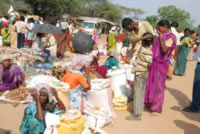Conclusion
 Our study indicates that the funds available per women is so negligible (if you use total women population in the district as a denominator) that the programmes being implemented has a near-zero impact on poverty, and there is no sense in maintaining the programme, except for research or piloting purposes. Our study indicates that the funds available per women is so negligible (if you use total women population in the district as a denominator) that the programmes being implemented has a near-zero impact on poverty, and there is no sense in maintaining the programme, except for research or piloting purposes.
The same conclusion is reached even if you replace total women population in the district as denominators with economically active women. Our study also highlights that there is no evidence, on poverty impact at any level, because almost all existing programmes are supply, not demand-driven. If research/piloting is assumed to be the main purpose, which it is not in most cases, then another set of questions must be answered; related to when the fruits of research will translate into scalable impact on poverty, how much will that cost, and where the resources for doing this are to come from?
One of the main issues before us is total funds available for supporting women in rural agriculture. Even if 6-8% economic growth continues in India, which cannot be guaranteed, no government in India is likely to have revenues in the near future, to make allocations for programmes on any scale significantly larger than what exists today. Pursuing that line of thinking is a sterile, non-starter.
 Even if all the financial resources are put together they are grossly inadequate to make an impact on poverty reduction. The stark reality is that there is no alternative but to increase budgets and to seek resources from elsewhere. In the foreseeable future this seems unlikely in India. Even if all the financial resources are put together they are grossly inadequate to make an impact on poverty reduction. The stark reality is that there is no alternative but to increase budgets and to seek resources from elsewhere. In the foreseeable future this seems unlikely in India.
Our findings also indicate that working with established institutions and people already enjoying power and authority has failed and will continue to fail and delivery services crucially required by rural women in the agriculture sector. That includes governments mainly, but also donors and NGOs to lesser but significant degrees and the private sector.
What is required across the rural sector is a radically different approach to targeting rural women who work in agriculture. An outline of this alternative strategy is highlighted below: What is required across the rural sector is a radically different approach to targeting rural women who work in agriculture. An outline of this alternative strategy is highlighted below:
- Find new ways to get more impact for funds already available
- Leverage resources, advantages and opportunities from markets
- Put people at the centre
- Find new ways to express and articulate demand; going beyond group discussions and rural appraisals.
- Create openings for unorganised as well as organised capital to flow into ventures created and managed by people
- Find ways for the poorest to overcome barriers, enter and participate in these processes
- Discover, monitor, find new ways to remove/reduce asymmetries and reduce privileges enjoyed by a few esp. information, access
- Develop institutional mechanisms suited for such a strategy.
|


